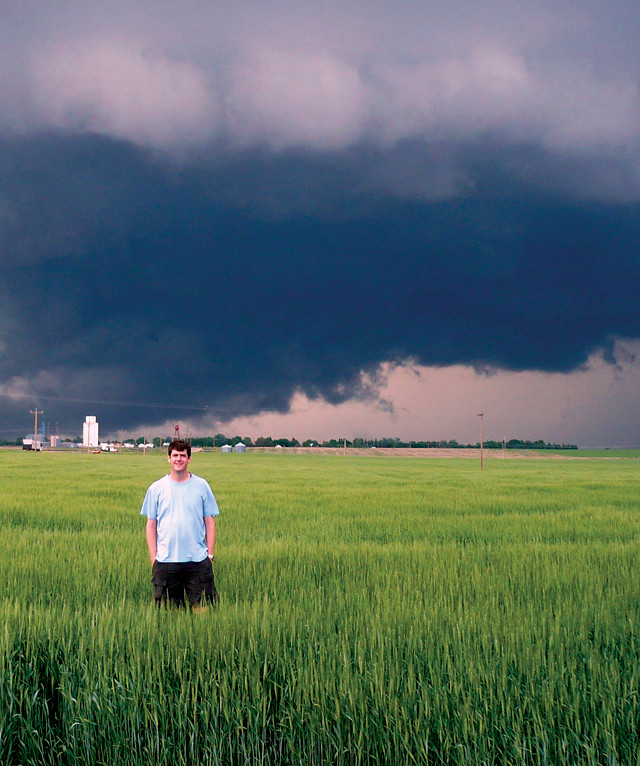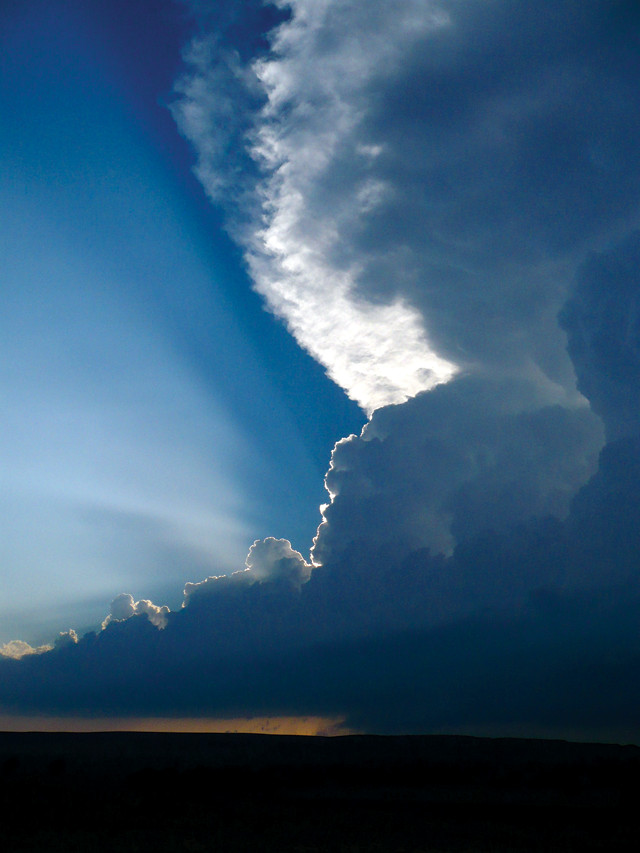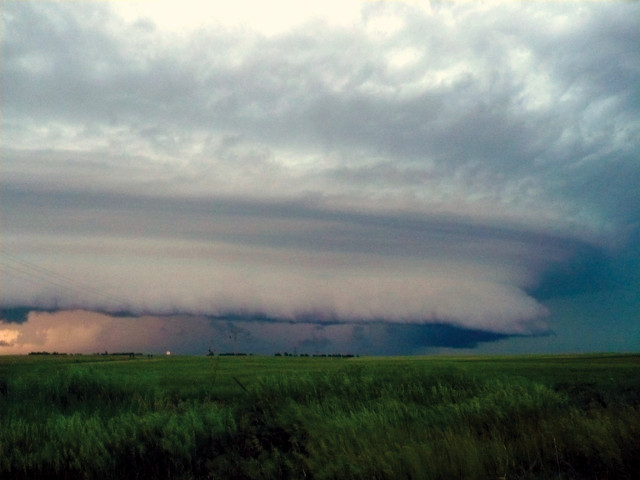
by Meg Marquardt Tuesday, May 22, 2018

Matthew Parker out in the field with the VORTEX2 project near Dalton, Neb. Credit: George Bryan
Matthew Parker In 1985, the television show NOVA dedicated an entire hour to the pioneers of tornado research, the men and women who first spent their summers crisscrossing the central United States in pursuit of data on the perfect tornado. Long before the blockbuster movie “Twister” sparked an entire legion of amateur storm chasers looking for a thrill, that NOVA documentary gave rise to Matthew Parker’s lifelong drive to understand the science behind one of Mother Nature’s deadliest weapons. Now an atmospheric scientist, Parker heads the convective storm research group at North Carolina State University in Raleigh. Among other projects, Parker is involved with VORTEX2 (Verification of the Origins of Rotation in Tornadoes Experiment 2), a descendant of the TOTO (Totable Tornado Observatory) system used in the NOVA documentary. As VORTEX2 closes out its last season of gathering data, Parker spoke with Meg Marquardt, an intern at EARTH magazine, about what sparked his interested in severe weather and how far tornado observation has come since those early days.
MM: When did you decide to go into meteorology?
MP: You know it’s funny, I really was interested in it from the time I was in elementary school — I think this is true of a lot of our current students as well. I have this legacy of doing science projects and book reports on tornadoes. I think from the time I was 8 or 9, I was pretty interested in it. I guess I always liked math and science. It was an interest, and it wasn’t that hard for me to keep pursuing.
MM: Were you already chasing storms at that age?
MP: Storm chasing wasn’t something that a lot of people did back then. But there was this special on PBS, a NOVA special, in which they showed a video of meteorologists deploying some instruments: It was the first time I had any awareness that something like that was going on. At the time, I liked the look of it. I was partly afraid and partly fascinated with tornadoes. It wasn’t clear to me that you could do that kind of work as a career, but it was something I wanted to learn more about.
MM: Did you always want to teach, or were you more interested in storm chasing?
MP: Storm chasing is not a viable profession for all but handful of people. I always wanted to be a researcher. I always liked the life of the mind that academia offered. And I like sharing my research with other people. As a graduate student, every time I found something new, I wanted to share it with other people.

After storms, such as this one near Canadian, Texas, in June 2010, VORTEX2 can catch glimpses of blue skies. Credit: Matt Parker
MM: Do you think your fear and fascination of tornadoes drew you to study convective storms?
MP: Yeah, I suppose so. There wasn’t a seminal moment where I can recall thinking, “This is what I have to do.” For as long as I was interested in being an atmospheric scientist, storms were the things I was fascinated with. It’s something I would like as a hobby even if it weren’t my job. It’s a very nice fit for the things that I’m interested in. It’s thrilling that I get to make a living doing research on this stuff.
MM: The first VORTEX project began in 1994. Why did it take so long for the second one to come about?
MP: There was a 15-year lag for a few good reasons. First, it takes a long time to actually process and quality-control the data and do any kind of useful scientific analysis. For example, we’re just at the point where we can do real analysis of the data we took a year ago. It may be another two or three years before we can write substantial papers on the data we took in 2009, and we took twice as much data in 2010. We’d do a real disservice if we didn’t mine every bit of information out of the data we’ve collected before we went back and asked for more money to go into the field again. A second reason is that federal funding for such massive projects is somewhat limited, to the extent where there can be only one or two projects of this size per year. There are a lot of other researchers vying to carry out equally interesting projects with that funding. I think the final reason is that we are reliant on technology in the field, so it was to our benefit to wait until there were new types of instruments and mobile communications for us to use. VORTEX2 was a huge leap beyond what people were able to do in VORTEX. The modern cellular network and the advent of affordable mobile broadband communications allowed us to coordinate our teams more effectively, and to maintain awareness of our locations with respect to storms. Also, our ability to collect mobile radar data has really grown in the past 10 years … we have rapid scanning radars in trucks that can tell us what’s changing in a storm every few seconds rather than every few minutes. So we will learn a lot more than we might have if we’d gone out five years ago.
MM: What’s going on with the VORTEX2 project now?
MP: The actual field campaign ended for good on June 15, 2010. We had two years in the field; last year we had five weeks and this year we had about six and half weeks. Hopefully there will still be funding for the two to three years it will take to do all the data analysis. But right now, data collection is done.

VORTEX2 was funded for two years, which proved fortuitous: The 2009 season saw few major storms like this one near Grant, Neb. Credit: Matt Parker
MM: The past two summers have seen fewer tornadoes compared to an average year. What does that mean for a project like VORTEX?
MP: True, 2009 was not a great year [for storms]; in fact the first three weeks of the project were well-below average. We were able to get a little additional supplemental funding for 2010 because data collection fell short of expectations in 2009. In a project this big, we have so many people and so much equipment that we can’t sit and wait for the best storm patterns. We have to commit to the part of the season when things are usually best and then just go for it. Things got better during our final two weeks in 2009, and continued after we were done. It was frustrating to see all of these storms happening when we couldn’t go out and operate. This year was good. The first week was tough, but after that it picked up. In one 17-day stretch, we went out 13 days and intercepted a supercell each day.
MM: How do you know where to go for a storm?
MP: We have a large group of people who are very experienced at storm forecasting. The decisions are largely made in a democratic fashion. When we are looking to make our decisions, we first look at the morning observations of temperature, humidity, winds and pressure. We also rely pretty heavily on computer forecast models to get us going in the right direction. And then there is a lot of reading the conditions and reacting. What are the afternoon observations telling us? You can’t usually correct for a misjudgment of 200 to 300 miles, but you can adjust to conditions if you are within 50 to 100 miles. There are people on the team who are just incredible at forecasting. We were in the right place more often than not.
MM: What were some of the best moments in the field?
MP: My team was responsible for collecting temperature, humidity and wind data from above the surface. We had four trucks that could launch weather balloons. Often the data we were collecting in real time helped our targeting [of storm locations]. There can be a lot of uncertainty when using the models to identify a target, so it was really satisfying to collect real data to help. There was a time in the Texas panhandle, June 13 of this year, when the models were painting a somewhat unfavorable picture for our operations. But when we sent up our balloons, we found that the environment was actually fantastic. Three tornadoes occurred during that mission! To go out and collect the data and then observe the storm that emerges from that environment is really satisfying. The other thing is that in the planning stages you’re applying for funding and you’re promising to do things that haven’t really been done before. To take 50 vehicles out on the road and position them in and around a storm, we weren’t sure how well we could deliver on everything we had promised. We’d done some smaller-scale trials, but we’d never tried to coordinate this many people with this many vehicles on one storm before. But the system worked well. On our best days, we were slicing and dicing the storms.
© 2008-2021. All rights reserved. Any copying, redistribution or retransmission of any of the contents of this service without the expressed written permission of the American Geosciences Institute is expressly prohibited. Click here for all copyright requests.